
Is your grinding process a major bottleneck? Slow cycle times hurt your bottom line and delay deliveries. You can speed up production by optimizing key areas of your operation.
To reduce grinding cycle time, focus on optimizing process parameters and upgrading your equipment. Employing automation for loading, using in-process measurement, and refining your coolant system are highly effective strategies that significantly boost efficiency and cut down on non-productive time.

As a factory owner in the heart of China’s abrasive industry for nearly 30 years, I’ve seen firsthand how small changes can lead to huge gains in efficiency. It’s not just about running the machine faster; it’s about working smarter. Many people think they need a massive investment in a new machine to see results. But often, the biggest wins come from understanding what’s actually slowing you down in the first place. You have to look at the entire cycle, not just the moment the wheel touches the part. So, let’s explore the factors that really matter and break down where you can make the most impact.
What are the key factors that influence grinding cycle time?
Struggling to pinpoint why your grinding cycles take so long? Guessing at solutions costs you time and money. Identifying the key influencing factors is the first crucial step to improvement.
The biggest factors influencing grinding cycle time are material removal rate, non-grinding time (loading, unloading, dressing), and process stability. Each component, from parameter settings and toolpaths to equipment maintenance and operator skill, plays a critical role in your overall production speed.

When we analyze a process for a client, we don’t just look at the grinding itself. We look at everything. Time is lost in many places you might not expect. The total cycle time is a sum of many small activities, and optimizing each one contributes to the final result. We can group these factors into three main areas.
Non-Value-Added Time: The Hidden Time Killer
This is all the time the machine is running but not actually grinding. It includes loading and unloading the workpiece, dressing the grinding wheel1 to keep it sharp, and stopping the process to measure the part. For many operations, this non-grinding time2 can be 50% or more of the entire cycle. Reducing this "dead time" is often the easiest way to increase output without changing the grinding process itself.
Process Parameters: The Speed Dial
These are the settings you control in the machine’s program. They directly influence how fast you can remove material. This includes the grinding wheel’s speed, the depth of cut, and the feed rate of the workpiece. Finding the perfect balance is key. If you are too aggressive, you risk damaging the workpiece or wearing out the wheel too fast. If you are too conservative, you are leaving productivity on the table. The right parameters depend heavily on the material, the wheel, and the machine’s condition.
Machine and Tool Condition: The Foundation
A machine that is not properly maintained will never perform at its peak. Worn-out spindle bearings, unstable guideways, or a poorly balanced grinding wheel will force you to run slower to achieve the required quality. A sharp, well-maintained grinding wheel is just as important. A dull wheel creates more heat and requires more force, which slows down the process and can cause thermal damage3. Regular maintenance is not a cost; it is an investment in consistent, high-speed production.
| Factor Group | Specific Influences | Impact on Cycle Time |
|---|---|---|
| Non-Value-Added Activities | Manual Loading/Unloading, In-Cycle Measurement, Wheel Dressing | Increases time when the machine is not producing. |
| Process Parameters | Wheel Speed, Depth of Cut, Feed Rate, Coolant Flow | Directly controls the material removal rate4 (MRR). |
| Equipment Condition | Machine Stability, Spindle Health, Wheel Sharpness & Balance | Limits the aggressiveness of parameters and process reliability. |
Which techniques are most effective for optimizing a grinding process for speed?
Are your grinding methods holding back your output? Using old techniques means you’re likely falling behind more efficient competitors. You can adopt modern, high-speed strategies to transform your productivity.
The most effective techniques are high-efficiency grinding methods like creep-feed or high-speed grinding. These maximize the material removal rate. Also, optimizing NC program toolpaths to minimize "air cutting" time dramatically reduces the non-productive portion of the cycle.

Simply spinning the wheel faster isn’t a strategy. A true strategy involves choosing the right technique for the job and programming it intelligently. At our factory, we often help clients analyze their parts to recommend a technique that will give them the best balance of speed and quality. Two major approaches stand out for a dramatic speed increase.
High-Efficiency Grinding Methods
Instead of traditional surface grinding with many light passes, modern techniques aim to remove material much more quickly.
- Creep-Feed Grinding5: This technique uses a very deep cut at a very slow feed rate. It can often finish a part’s profile in a single pass. It requires a stable machine and a wheel designed for high porosity to allow for good coolant flow and chip removal. It is excellent for grinding complex profiles from a solid block of material.
- High-Speed Grinding (HSG): This involves increasing the wheel’s surface speed significantly. Higher wheel speeds lead to smaller, thinner chips and less grinding force per abrasive grain. This allows you to increase the feed rate dramatically, boosting the material removal rate4. It requires a machine built for high RPMs and a perfectly balanced wheel system.
Smart Programming and Toolpaths
This is an area where huge gains can be made with zero investment in new hardware. Every second the grinding wheel is moving but not touching the workpiece—what we call "air cutting6"—is wasted time. I remember a client who was producing automotive components. Their cycle time was acceptable, but not great. We analyzed their program and found that the wheel was taking a long, slow path to approach and retract from the part. By simply optimizing the toolpath to make these movements faster and more direct, we cut their cycle time by 15%. This was pure profit for them, as it required no new equipment, just smarter programming. Using programming macros7 can also automate repetitive tasks and ensure that every cycle runs in the most efficient way possible.
Can upgrading the grinding wheel or coolant system shorten production time?
Think you need a whole new machine to get faster? That’s a costly assumption. You can unlock significant speed improvements by upgrading just the grinding wheel and the coolant system.
Absolutely. A superior grinding wheel allows for more aggressive cutting parameters, increasing material removal rates. An optimized coolant system improves heat dissipation, prevents workpiece burn, and keeps the wheel sharp longer. Both directly contribute to shorter cycle times and better quality.

Your machine is only as good as the tools you put in it. The grinding wheel and the coolant are active parts of the process, not just passive accessories. Upgrading them can have a bigger impact on cycle time than you might think. We are a grinding tool factory, so this is our area of expertise. We’ve spent decades developing abrasives that help our customers go faster.
The Grinding Wheel: Your Point of Contact
The grinding wheel is what does the work. Its performance dictates your speed. A standard, low-cost wheel may force you to use slow feed rates and light cuts to avoid burn marks or poor surface finish. Upgrading to a modern wheel, especially a superhard abrasive like CBN or diamond, can transform your process. These wheels can handle much higher temperatures and cutting forces. This means you can increase your feed rates and depth of cut significantly. Suddenly, you are removing more material in less time. We often work with our B2B partners to provide OEM solutions, creating a wheel with the perfect abrasive grain, grit size, and bond structure for their specific material and speed goals. This custom approach ensures they are not just buying a product, but a solution that directly shortens their cycle time.
The Coolant System: The Unsung Hero
Coolant does more than just cool the part. It lubricates the cutting zone, flushes away abrasive chips, and helps keep the grinding wheel clean and sharp. A weak or poorly aimed coolant stream is a major cause of slow cycle times. If the cooling is insufficient, you have to slow down the process to prevent thermal damage to the workpiece. Modern coolant system8s use high-pressure pumps and programmable nozzles. Systems like the "SmartJet9" mentioned in industry discussions can precisely aim a powerful stream of coolant exactly where it is needed. This improved cooling efficiency allows for much more aggressive grinding parameters, directly contributing to shorter cycles.
How can automation reduce non-value-added time in a grinding cycle?
Is manual loading and part measurement slowing your whole line down? This non-grinding time adds up, killing your efficiency. Automation eliminates these manual delays for nearly continuous production.
Automation drastically cuts non-value-added time by using robotic systems for loading and unloading parts. It also integrates in-process measurement tools that check dimensions automatically. This eliminates manual handling and inspection, keeping the machine running and producing parts without interruption.

For years, the focus of optimization was on the cutting part of the cycle. But as we’ve discussed, the non-grinding time is often the biggest thief of productivity. This is where automation delivers incredible value. By automating the manual tasks that happen before and after the grinding, you allow the machine to do what it does best: make parts. And it can do it continuously, with minimal human intervention.
Automated Loading and Unloading
This is the most obvious application of automation in grinding. Instead of an operator opening the door, manually placing a part, clamping it, and starting the cycle, a robot does it all. For high-volume production, a six-axis robot can tend one or more machines, running 24/7. This not only speeds up the loading process but also makes it perfectly consistent. For factories with smaller batches and more variety, flexible systems exist that use gantries or other loaders to quickly swap parts. The result is the same: the machine’s spindle stops for the shortest possible time between parts, maximizing its utilization and your output.
In-Process Measurement and Compensation
This is a more advanced but powerful form of automation. Traditionally, after grinding a critical part, you would have to stop the machine, unclamp the part, and take it to a separate quality control station with a CMM to measure it. If it was out of tolerance, you’d have to figure out the adjustment and try again. This process can take a long time. In-process measurement systems use a probe, often a laser, mounted inside the machine. After a grinding pass, the probe measures the part while it is still clamped. The machine’s control system can then automatically compare the measurement to the target dimension and apply a correction for the next pass. This completely eliminates the downtime for manual inspection and dramatically reduces scrap rates.
Conclusion
To shorten grinding cycles, you must analyze your process, use better techniques and tools, and implement automation. These steps will directly boost your factory’s productivity and overall output.
-
Learn how a superior grinding wheel can enhance your grinding process and speed. ↩
-
Discover strategies to minimize non-grinding time and boost productivity. ↩
-
Understand the factors leading to thermal damage and how to mitigate them. ↩
-
Explore the concept of material removal rate to enhance your grinding operations. ↩ ↩
-
Understand the advantages of Creep-Feed Grinding for complex profiles and faster production. ↩
-
Find out how to reduce air cutting time to improve overall grinding efficiency. ↩
-
Learn how programming macros can automate tasks and improve grinding efficiency. ↩
-
Learn about the importance of a well-designed coolant system in enhancing grinding efficiency. ↩
-
Learn about SmartJet technology and its role in enhancing coolant application in grinding. ↩
Written by
leeon
You may also be interested in:
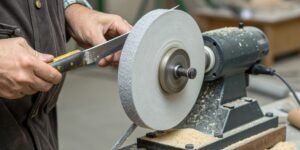
How to use a hard felt bench grinding wheel on knives?
Getting a razor-sharp, polished edge on a knife can be frustrating and slow. A dull knife is dangerous, and using the wrong tool can easily
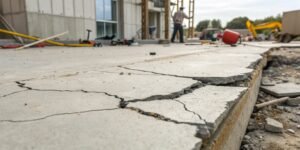
What are grinding cracks and how do you stop them?
Are tiny cracks appearing on your ground surfaces? This problem leads to part failure, wasting time and money. You can solve it by understanding the
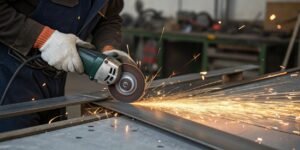
What does an angle grinder do that other tools can't?
Struggling with tools for multiple tasks? Carrying a heavy toolbox is inefficient. An angle grinder replaces many tools, saving you time and effort on the

Do you regularly sharpen your chisels? If so, how?
A dull chisel ruins wood and causes frustration. This wastes time and expensive materials. Learning to sharpen correctly is the simple, game-changing solution you need
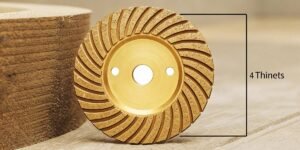
How is a grinding wheel specified?
Confused by the codes on a grinding wheel? Making the wrong choice costs money and ruins parts. Let me show you how to read them
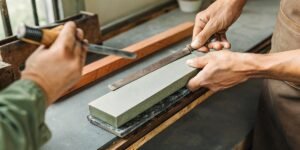
How to sharpen wood chisels by hand?
Dull chisels tear wood, ruin projects, and waste your time. Learning to sharpen them by hand restores their precision, making your work effortless and enjoyable
